<< Previous | Displaying results 51-75 of 457 for "Survivors" | Next >>
A child survivor arrives at Haifa port on board the Aliyah Bet ("illegal" immigration) ship Mataroa. The British denied the passengers entry into Palestine and deported them to Cyprus detention camps. July 15, 1945.
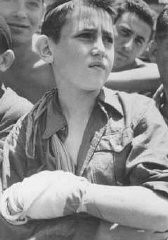
Camp survivors crowded in barracks at liberation. Dachau, Germany, April 29-May 1, 1945.
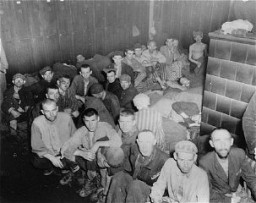
The Dachau concentration camp, northwest of Munich, Germany, was the first regular concentration camp the Nazis established in 1933. About twelve years later, on April 29, 1945, US armed forces liberated the camp. There were some 30,000 starving prisoners in the camp at that time. In this footage, soldiers of the US Seventh Army feed and disinfect survivors of the camp.
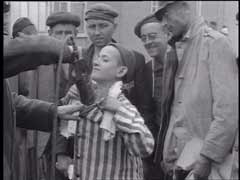
A US army officer (far right) poses with survivors of the Ohrdruf camp, a subcamp in the Buchenwald camp system. Photograph taken after the liberation of the camp. Ohrdruf, Germany, April 1945.

Survivors in Buchenwald just after liberation. Troops of the US 6th Armored Division entered Buchenwald on April 11, and troops of the 80th Infantry arrived on April 12. Buchenwald, Germany, photograph taken ca. April 11, 1945.
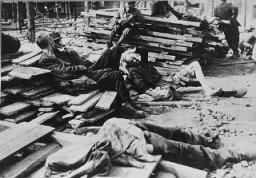
Lt. Col. J.W. Branch, Chief Surgeon of the 6th Armored Division, provides medical care to a Hungarian survivor in Penig, a subcamp of Buchenwald. Penig, Germany, April 26, 1945.
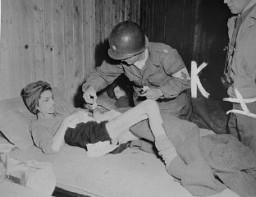
A war crimes investigation photo of the disfigured leg of a survivor from Ravensbrück, Polish political prisoner Helena Hegier (Rafalska), who was subjected to medical experiments in 1942. This photograph was entered as evidence for the prosecution at the Medical Trial in Nuremberg. The disfiguring scars resulted from incisions made by medical personnel that were purposely infected with bacteria, dirt, and slivers of glass.
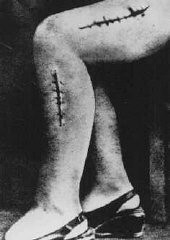
Romani (Gypsy) survivors in a barracks of the Bergen-Belsen concentration camp during liberation. Germany, after April 15, 1945.
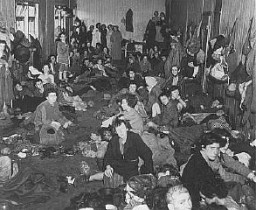
Listen to excerpts from oral testimonies to learn from survivors themselves about their individuals experiences, actions, and choices.
Carl Atkin was United Nations Relief and Rehabilitation Administration (UNRRA) director at the Deggendorf displaced persons camp. He received a songbook created by the survivors in his care. This page shows one of the songs compiled in the book.
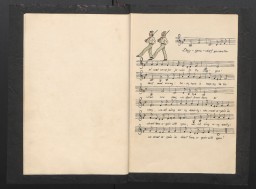
Rabbi Abraham Klausner was a US Army military chaplain. He arrived in the Dachau concentration camp in May 1945. He was attached to the 116th evacuation hospital unit and worked for about five years in displaced persons camps, assisting Jewish survivors.
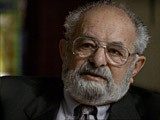
Five Jewish survivors pose for a US Signal Corps photographer in front of Block 2 in the Hanover-Ahlem camp, a subcamp of Neuengamme. Hanover-Ahlem, Germany, April 11, 1945.
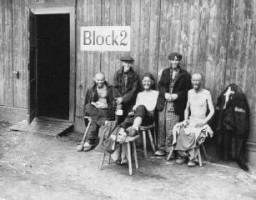
A chaplain with the 82nd Airborne Division helps a survivor board a truck that will evacuate him from the Wöbbelin concentration camp to an American field hospital. Germany, May 4, 1945.
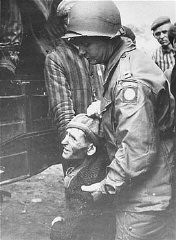
Two survivors prepare food outside the barracks in Dachau, Germany, May 1945. This image is among the commonly reproduced and distributed images of liberation. These photographs provided powerful documentation of the crimes of the Nazi era.
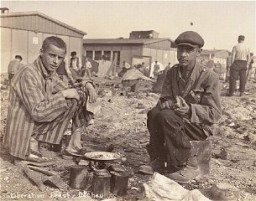
Soon after liberation, an emaciated child survivor is carried out of camp barracks by Soviet first-aid workers. Auschwitz, Poland, after January 27, 1945. This photograph is a still image from Soviet film of the liberation of Auschwitz.
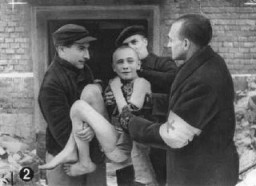
A 13-year-old orphan, a survivor of the Mauthausen concentration camp. Photograph taking following liberation of the camp. Austria, May 1945.
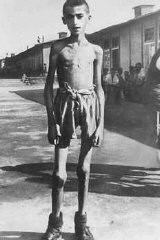
Soon after liberation, a Soviet physician examines Auschwitz camp survivors. Poland, February 18, 1945. This photograph is a still image from Soviet film of the liberation of Auschwitz.

Learn about the experiences of 6 Holocaust survivors whose journeys brought them to the United States: Thomas Buergenthal, Aron and Lisa Derman, Regina Gelb, Blanka Rothschild, and Norman Salsitz.
US troops pull the survivors of a sunken craft onto the shores of the Normandy beaches on D-Day. Normandy, France, June 6, 1944.
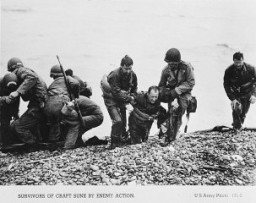
Rabbi Abraham Klausner was a US Army military chaplain. He arrived in the Dachau concentration camp in May 1945. He was attached to the 116th evacuation hospital unit and worked for about five years in displaced persons camps, assisting Jewish survivors.
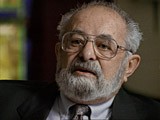
Herbert graduated from Yale in 1938. He became a rabbi and worked very closely with American Jewish leader Stephen S. Wise. He became a chaplain in the US Army during World War II. In the spring of 1945, he went to Europe. When the war ended, he was recruited by David Ben-Gurion into the Aliyah Bet ("illegal" immigration) operation of the Hagana. This involved smuggling Jews from eastern Europe through Germany to Palestine. He worked with displaced persons, mainly in Berlin and the American zone of…

Tarmo Holma is a veteran of the 11th Armored Division. During the invasion of German-held Austria, in May 1945 the 11th Armored (the "Thunderbolt" division) overran two of the largest Nazi concentration camps in the country: Mauthausen and Gusen.
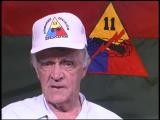
Sophie was born Selma Schwarzwald to parents Daniel and Laura in the industrial city of Lvov, two years before Germany invaded Poland. Daniel was a successful businessman who exported timber and Laura had studied economics. The Germans occupied Lvov in 1941. After her father's disappearance on her fifth birthday in 1941, Sophie and her mother procured false names and papers and moved to a small town called Busko-Zdroj. They became practicing Catholics to hide their identities. Sophie gradually forgot that…
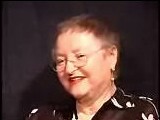
Leah grew up in Praga, a suburb of Warsaw, Poland. She was active in the Ha-Shomer ha-Tsa'ir Zionist youth movement. Germany invaded Poland in September 1939. Jews were forced to live in the Warsaw ghetto, which the Germans sealed off in November 1940. In the ghetto, Leah lived with a group of Ha-Shomer ha-Tsa'ir members. In September 1941, she and other members of the youth group escaped from the ghetto to a Ha-Shomer ha-Tsa'ir farm in Zarki, near Czestochowa, Poland. In May 1942, Leah became a courier…

We would like to thank Crown Family Philanthropies, Abe and Ida Cooper Foundation, the Claims Conference, EVZ, and BMF for supporting the ongoing work to create content and resources for the Holocaust Encyclopedia. View the list of donor acknowledgement.